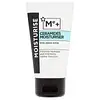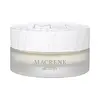What's inside
What's inside
 Key Ingredients
Key Ingredients

 Benefits
Benefits

 Concerns
Concerns

 Ingredients Side-by-side
Ingredients Side-by-side

Water
Skin ConditioningAluminum Starch Octenylsuccinate
AbsorbentGlycerin
HumectantPropylene Glycol
HumectantCetearyl Alcohol
EmollientPropanediol
SolventGlyceryl Stearate
EmollientButylene Glycol
HumectantSorbitan Stearate
EmulsifyingDimethicone
EmollientIsohexadecane
EmollientSodium Polyacrylate
AbsorbentPhenoxyethanol
PreservativeBetaine
HumectantCaprylyl Glycol
EmollientXanthan Gum
EmulsifyingPEG-100 Stearate
Sodium Lauroyl Lactylate
EmulsifyingSodium PCA
HumectantSodium Lactate
BufferingDisodium EDTA
Sodium Hyaluronate
HumectantTocopheryl Acetate
AntioxidantArginine
MaskingAspartic Acid
MaskingPCA
HumectantCeramide NP
Skin ConditioningGlycine
BufferingAlanine
MaskingCholesterol
EmollientCeramide AP
Skin ConditioningPhytosphingosine
Skin ConditioningSerine
MaskingValine
MaskingCarbomer
Emulsion StabilisingEthylhexylglycerin
Skin ConditioningIsoleucine
Skin ConditioningProline
Skin ConditioningThreonine
Histidine
HumectantPhenylalanine
MaskingCeramide EOP
Skin ConditioningWater, Aluminum Starch Octenylsuccinate, Glycerin, Propylene Glycol, Cetearyl Alcohol, Propanediol, Glyceryl Stearate, Butylene Glycol, Sorbitan Stearate, Dimethicone, Isohexadecane, Sodium Polyacrylate, Phenoxyethanol, Betaine, Caprylyl Glycol, Xanthan Gum, PEG-100 Stearate, Sodium Lauroyl Lactylate, Sodium PCA, Sodium Lactate, Disodium EDTA, Sodium Hyaluronate, Tocopheryl Acetate, Arginine, Aspartic Acid, PCA, Ceramide NP, Glycine, Alanine, Cholesterol, Ceramide AP, Phytosphingosine, Serine, Valine, Carbomer, Ethylhexylglycerin, Isoleucine, Proline, Threonine, Histidine, Phenylalanine, Ceramide EOP
Water
Skin ConditioningSqualane
EmollientGlycerin
HumectantCetyl Alcohol
EmollientHydrogenated Ethylhexyl Olivate
EmollientTetrahexyldecyl Ascorbate
AntioxidantHelianthus Annuus Seed Oil Unsaponifiables
EmollientStearic Acid
CleansingAcetyl Glucosamine
Skin ConditioningSorbitan Stearate
EmulsifyingPhenoxyethanol
PreservativeAlcohol
AntimicrobialHydrogenated Lecithin
EmulsifyingSodium PCA
HumectantHydroxypropyl Methylcellulose Stearoxy Ether
Sodium Lactate
BufferingPalmaria Palmata Extract
Skin ProtectingMaltodextrin
AbsorbentArginine
MaskingSodium Stearoyl Glutamate
CleansingTremella Fuciformis Sporocarp Extract
AntioxidantOryza Sativa Bran Extract
Skin ConditioningHydrogenated Olive Oil Unsaponifiables
EmollientAspartic Acid
MaskingHydrogenated Phosphatidylcholine
EmulsifyingPCA
HumectantSodium Phytate
Bisabolol
MaskingCaffeine
Skin ConditioningXanthan Gum
EmulsifyingHelianthus Annuus Seed Oil
EmollientScenedesmus Rubescens Extract
Skin ConditioningMethylglucoside Phosphate
Skin ConditioningSodium Methyl Stearoyl Taurate
CleansingLeontopodium Alpinum Flower/Leaf Extract
Skin ConditioningHydrolyzed Hyaluronic Acid
HumectantGlycine
BufferingRosmarinus Officinalis Leaf Extract
AntimicrobialAlanine
MaskingCopper Lysinate/Prolinate
Skin ConditioningLecithin
EmollientSerine
MaskingValine
MaskingResveratrol
AntioxidantProline
Skin ConditioningThreonine
Isoleucine
Skin ConditioningPlankton Extract
Skin ConditioningArabidopsis Thaliana Extract
AntioxidantMicrococcus Lysate
Skin ConditioningCoffea Arabica Seed Extract
MaskingIlex Paraguariensis Leaf Extract
PerfumingHelianthus Annuus Seed Extract
Skin ConditioningCholesterol
EmollientSodium Hydroxide
BufferingHistidine
HumectantPhenylalanine
MaskingSodium Benzoate
MaskingTocopheryl Acetate
AntioxidantTocopherol
AntioxidantTheobroma Cacao Seed Butter
EmollientChrysanthemum Parthenium Extract
Skin ConditioningPotassium Sorbate
PreservativeErgothioneine
AntioxidantWater, Squalane, Glycerin, Cetyl Alcohol, Hydrogenated Ethylhexyl Olivate, Tetrahexyldecyl Ascorbate, Helianthus Annuus Seed Oil Unsaponifiables, Stearic Acid, Acetyl Glucosamine, Sorbitan Stearate, Phenoxyethanol, Alcohol, Hydrogenated Lecithin, Sodium PCA, Hydroxypropyl Methylcellulose Stearoxy Ether, Sodium Lactate, Palmaria Palmata Extract, Maltodextrin, Arginine, Sodium Stearoyl Glutamate, Tremella Fuciformis Sporocarp Extract, Oryza Sativa Bran Extract, Hydrogenated Olive Oil Unsaponifiables, Aspartic Acid, Hydrogenated Phosphatidylcholine, PCA, Sodium Phytate, Bisabolol, Caffeine, Xanthan Gum, Helianthus Annuus Seed Oil, Scenedesmus Rubescens Extract, Methylglucoside Phosphate, Sodium Methyl Stearoyl Taurate, Leontopodium Alpinum Flower/Leaf Extract, Hydrolyzed Hyaluronic Acid, Glycine, Rosmarinus Officinalis Leaf Extract, Alanine, Copper Lysinate/Prolinate, Lecithin, Serine, Valine, Resveratrol, Proline, Threonine, Isoleucine, Plankton Extract, Arabidopsis Thaliana Extract, Micrococcus Lysate, Coffea Arabica Seed Extract, Ilex Paraguariensis Leaf Extract, Helianthus Annuus Seed Extract, Cholesterol, Sodium Hydroxide, Histidine, Phenylalanine, Sodium Benzoate, Tocopheryl Acetate, Tocopherol, Theobroma Cacao Seed Butter, Chrysanthemum Parthenium Extract, Potassium Sorbate, Ergothioneine
 Reviews
Reviews

Ingredients Explained
These ingredients are found in both products.
Ingredients higher up in an ingredient list are typically present in a larger amount.
Alanine is an amino acid and is already found in the human body. Our skin uses alanine to build collagen, elastin, and keratin.
Arginine is an amino acid that is important for human development. Your body uses is it to produce hair keratin and skin collagen.
As a cosmetic ingredient, Arginine has antioxidant properties and can also help repair damaged skin. This ingredient is derived either synthetically or from animals.
Arginine isn't fungal acne safe when used in the presence of other lipids (fats, fatty acids, oils, esters, etc). Oils and fats occur naturally within the skin, so take caution when using Arginine if you're prone to fungal acne.
Learn more about ArginineAspartic Acid is an amino acid that our bodies produce naturally. It is an antioxidant.
Our body uses Aspartic Acid to help build collagen and elastin. It also plays a role in hydrating skin.
Cholesterol is a class of organic molecules called lipids. It helps hydrate your skin and is essential to having a healthy skin barrier.
Our skin naturally contains cholesterol in the outermost layer. Besides cholesterol, it also contains ceramides and fatty acids. Cholesterol makes up about 1/4 of your skin's outer layer and barrier. Your skin barrier is responsible for keeping allergens and microbes out. Having a healthy skin barrier is also responsible for keeping your skin firm and plump.
Our bodies use cholestrol to create vitamin D, steroid hormones, and more.
Learn more about CholesterolGlycerin is already naturally found in your skin. It helps moisturize and protect your skin.
A study from 2016 found glycerin to be more effective as a humectant than AHAs and hyaluronic acid.
As a humectant, it helps the skin stay hydrated by pulling moisture to your skin. The low molecular weight of glycerin allows it to pull moisture into the deeper layers of your skin.
Hydrated skin improves your skin barrier; Your skin barrier helps protect against irritants and bacteria.
Glycerin has also been found to have antimicrobial and antiviral properties. Due to these properties, glycerin is often used in wound and burn treatments.
In cosmetics, glycerin is usually derived from plants such as soybean or palm. However, it can also be sourced from animals, such as tallow or animal fat.
This ingredient is organic, colorless, odorless, and non-toxic.
Glycerin is the name for this ingredient in American English. British English uses Glycerol/Glycerine.
Learn more about GlycerinThis ingredient is an amino acid that helps build proteins and moisturizes skin. It is already present in our skin as our bodies produce them naturally.
Glycine already plays a role in helping keep our skin moisturized as amino acids transport moisture throughout our skin.
As collagen is made up of glycine and other amino acids, it is believed glycine may help our skin produce more collagen.
Learn more about GlycineHistidine is a semi-essential amino acid used by our bodies to create protein. It has humectant and skin conditioning properties.
Our bodies use histidine to create filaggrin - filaggrin is a structural protein that the skin uses in maintaining skin barrier.
One study found histidine and carnosine to be a dynamic duo for your skin:
Oral histidine has also been found to help with filaggrin-deficit skin disorders such as atopic dermatitis.
Why is it considered a semi-essential amino acid? This is because adults are able to create it but children must get it from their diet.
Learn more about HistidineIsoleucine is an amino acid that helps reinforce our skin barrier. This amino acid plays a role in creating protein for the body.
Fun fact: Isoleucine is found in meat, fish, dairy, legumes, and nuts.
PCA is derived from amino acids and is naturally found in our skin's barrier.
As a humectant, PCA helps draw and hold moisture to the skin. Studies show it is effective at helping the skin stay hydrated long-term.
Phenoxyethanol is a preservative that has germicide, antimicrobial, and aromatic properties. Studies show that phenoxyethanol can prevent microbial growth. By itself, it has a scent that is similar to that of a rose.
It's often used in formulations along with Caprylyl Glycol to preserve the shelf life of products.
Phenylalanine is an amino acid. It is a skin soothing and hydrating ingredient. Amino acids play a crucial role in wound healing and skin hydration.
This ingredient is also used to help even out skin tone due to its ability to disrupt the melanin production process.
Two structures of phenylalanine exist: L-phenylalanine and D-phenylalanine. L-phenylalanine is essential, this means our bodies cannot produce it naturally and we must get it from foods. Our bodies convert D-phenylalanine to neurotransmitters, and D-phenylalanine is found in our bodies naturally.
Some foods that contain L-phenylalanine include eggs, soybeans, beef, milk.
Learn more about PhenylalanineProline is an amino-acid. It helps moisturize the skin and plays an important role in creating proteins.
Our skin uses proline as one of the building blocks for producing collagen.
In medicine, proline is used as an osmoprotectant. This means it helps prevent oxidative degradation in other drugs.
Our bodies are able to produce proline naturally, but certain conditions may inhibit this production. In that case, proline can be obtained from eating egg whites, soy protein, dairy products, asparagus, mushrooms, and seaweed.
Learn more about ProlineSerine is an amino acid naturally found in our body. Our bodies use amino acids to create protein.
Amino-acids help give keep our skin hydrated. They play an important role in the skin barrier, which keeps the skin plump and firm.
Serine is a non-essential amino acid, meaning we don't need to obtain it from eating foods.
Learn more about SerineSodium Lactate is the sodium salt of lactic acid, an AHA. It is a humectant and sometimes used to adjust the pH of a product.
This ingredient is part of our skin's NMF, or natural moisturizing factor. Our NMF is essential for the hydration of our top skin layers and plasticity of skin. NMF also influences our skin's natural acid mantle and pH, which protects our skin from harmful bacteria.
High percentages of Sodium Lactate can have an exfoliating effect.
Fun fact: Sodium Lactate is produced from fermented sugar.
Learn more about Sodium LactateSodium PCA is the sodium salt of pyroglutamic acid. It is naturally occurring in our skin's natural moisturizing factors where it works to maintain hydration.
The PCA stands for pyrrolidone carboxylic acid, a natural amino acid derivative.
This ingredient has skin conditioning, anti-inflammatory, and humectant properties. Humectants help hydrate your skin by drawing moisture from the air. This helps keep your skin moisturized.
Learn more about Sodium PCASorbitan Stearate comes from sorbitol and stearic acid. Sorbitol is a type of sugar and stearic acid is a fatty acid.
It is used as an emulsifier and helps ingredients stay together by creating water-in-oil emulsions.
This ingredient may not be Malassezia folliculitis, or fungal-acne safe.
Threonine is an amino-acid. It helps hydrate the skin and has antioxidant benefits.
Our skin uses threonine for creating collagen and elastin. Humans are not able to create threonine and must get it through eating foods such as fish, lentils, poultry, sesame seeds, and more.
Tocopheryl Acetate is AKA Vitamin E. It is an antioxidant and protects your skin from free radicals. Free radicals damage the skin by breaking down collagen.
One study found using Tocopheryl Acetate with Vitamin C decreased the number of sunburned cells.
Tocopheryl Acetate is commonly found in both skincare and dietary supplements.
Learn more about Tocopheryl AcetateValine is an essential amino acid. It is used by our bodies for tissue repair and muscle growth.
An essential amino acid is one in which our bodies cannot naturally produce so we must get them through diet. Foods such as eggs, dairy, red meat, and fish contain valine.
This ingredient can either be derived from an animal product or be synthetically created.
Learn more about ValineWater. It's the most common cosmetic ingredient of all. You'll usually see it at the top of ingredient lists, meaning that it makes up the largest part of the product.
So why is it so popular? Water most often acts as a solvent - this means that it helps dissolve other ingredients into the formulation.
You'll also recognize water as that liquid we all need to stay alive. If you see this, drink a glass of water. Stay hydrated!
Learn more about WaterXanthan gum is used as a stabilizer and thickener within cosmetic products. It helps give products a sticky, thick feeling - preventing them from being too runny.
On the technical side of things, xanthan gum is a polysaccharide - a combination consisting of multiple sugar molecules bonded together.
Xanthan gum is a pretty common and great ingredient. It is a natural, non-toxic, non-irritating ingredient that is also commonly used in food products.
Learn more about Xanthan Gum